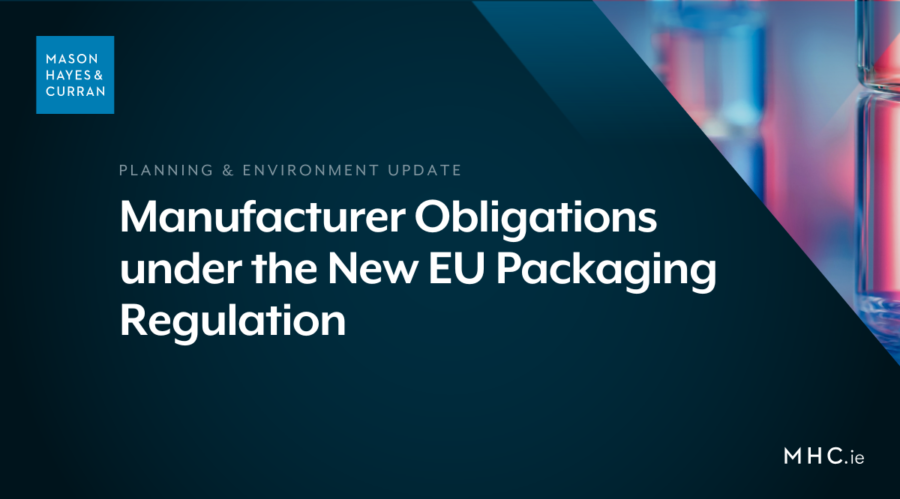Manufacturer Obligations under the New EU Packaging Regulation

Our Environment team reviews the obligations that manufacturers need to be aware of under the EU’s new Packaging and Packaging Waste Regulation. In addition, they also outline the deadlines for compliance.
In a previous update, our Environment team examined how the new EU Packaging and Packaging Waste Regulation is set to impact importers and producers.
In this article, we set out the key obligations for manufacturers to be aware of and the timeline for implementation of the new regime.
The Packaging and Packaging Waste Regulation[1] came into force on 11 February 2025. The measures will apply on a phased basis, starting from 12 August 2026. Entities have some time to understand their new obligations and make any necessary changes to their packaging and supply chains.
The Regulation has a broad scope. It applies to all packaging, regardless of the material used, and to all packaging waste. It imposes requirements for the entire life cycle of packaging, from manufacture to use to disposal. In addition, the Regulation imposes obligations on multiple different operators in that packaging life cycle.
The core objectives of the Regulation include:
- Reducing packaging waste
- Introducing enhanced recyclability and reusability requirements, and
- Reducing substances of concern in packaging, especially in food packaging.
Who are ‘manufacturers’?
The Regulation broadly defines a ‘manufacturer’ as any entity that:
- Manufactures packaging or packaged products, or
- Has packaging or packaged products designed or manufactured on its behalf, or under its own name or trademark. It does not matter whether the name or trademark is visible on the packaging.
Key obligations for manufacturers
Articles 5 to 12 of the Regulation set out an extensive suite of obligations that manufacturers must comply with when placing packaging or packaged products onto the EU market. We have summarised some of the key changes:
Harmful substances
- Food packaging containing certain levels of per- and polyfluoroalkyl substances (PFAS) will be prohibited. This applies from 12 August 2026.
- The presence or concentration of substances (1) harmful to human health or the environment, or (2) difficult to re-use or recycle, must be minimised. This applies from 12 August 2026.
Recyclable and recycled packaging
- All packaging placed on the market must be recyclable. To be considered ‘recyclable’ the packaging must be:
- Designed for material recycling, which enables the use of secondary raw materials of sufficient quality. This applies from 1 January 2030, and
- Capable of separate collection as waste and recyclable at scale. This applies from 1 January 2035.
- Any packaging containing plastic must contain a certain minimum percentage content of recycled post-consumer plastic. The percentage varies depending on the type of packaging. The obligation commences from 1 January 2030, with an increase in the minimum percentages from 1 January 2040.
Minimisation of packaging
- Packaging that aims to increase the perceived volume of the product, such as packaging with double walls or unnecessary layers, will be prohibited from 12 August 2026.
- Packaging must be designed so that its weight and volume is reduced only to what is necessary to ensure its functionality from 1 January 2030.
Labelling
- Packaging must conform with new harmonised labelling requirements to inform consumers of its composition, for the purposes of disposal, from 12 August 2028.
- Packaging that is reusable must bear a label informing consumers that it is reusable from 12 August 2029.
- QR codes or digital links must be provided on labels providing additional disposal and composition information.
Conformity assessment
- Manufacturers will be required to carry out a conformity assessment before placing packaging on the market from 12 August 2026. Manufacturers must keep certain technical information for set periods to show that their packaging meets the requirements of the Regulation.
Other obligations on ‘economic operators’ and ‘producers’
Manufacturers also fall into the broader category of ‘economic operators’ under the Regulation. They might also be a ‘producer’ under the Regulation depending on:
- Their location within or outside the EU, and
- Their position in the supply chain.
As ‘producers’ and/or ‘economic operators’, manufacturers may need to comply with additional obligations, depending on the type of packaging they sell or supply. A summary of these obligations is provided in our previous article.
How should manufacturers prepare for compliance?
As a first step, all entities established within or selling into the EU should check how they are categorised under the Regulation. Are you an importer, a distributor, or a manufacturer? This classification has a huge impact on the scope of the obligations, so it is important to get it right from the outset.
The next step requires a review of the obligations that are applicable to your entity, including the dates that each will come into effect. You will then be able to assess what changes might be required to your operations to enable compliance, and how long you have to implement these changes.
The bottom line for manufacturers
As the new measures come into force, manufacturers will be required to comply with their obligations under the Regulation, or face penalties for non-compliance. The penalties, which will include fines, are due to be set out in supplemental regulations devised by each Member State.
The Regulation is long, detailed and extremely complex. A lot of preparation is likely to be required to ensure that you are compliance ready.
With the first phase of obligations due to take effect from August 2026, manufacturers should take immediate steps to familiarise themselves and ensure appropriate procedures are put in place to comply with the Regulation.
For more information on the impact of the Regulation on your operations, contact a member of our Environment team.
[1] Regulation (EU) 2025/40 of the European Parliament and of the Council of 19 December 2024 on packaging and packaging waste, amending Regulation (EU) 2019/1020 and Directive (EU) 2019/904, and repealing Directive 94/62/EC
Share this:



